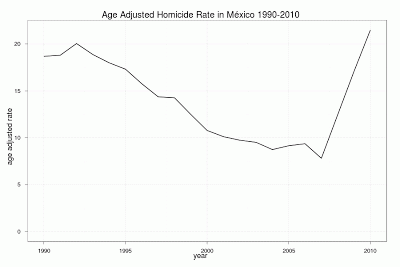The Mexican government had actually released preliminary homicide data a couple of months ago, but I though it looked incomplete so I didn’t blog about it. For some reason (too much ponche?) the INEGI hasn’t issued a press release with the final data —including more than 1,000 previously uncounted homicides. Hopefully they’ll do it sometime soon.
Because of the cutoff date for registering deaths of December 31 there is always an under-counting of homicides during the last year for which data is available. Taking this into account, the number of homicides in Mexico for the last few years has been:
| Year | Homicides |
| 2004 | 9,347 |
| 2005 | 9,983 |
| 2006 | 10,426 |
| 2007 | 8,840 |
| 2008 | 14,175 |
| 2009 | 19,771 |
| 2010 | 25,800 (25,000 in the database) |
Problems with the data
Given previous problems with the recording of homicides I did some quick checks of the data and found the following issues:
- The 55 bodies found in the mass grave in the municipality of Taxco were not recorded in the database (not even as accidents). In the drug war-related homicide database 55 deaths were recorded during the month of May.
- There were an unusually high number of deaths of unknown injury intent in the state of Tamaulipas, and many parts of the state had more drug war-related homicides than total homicides.
- In the muncipality of San Fernando 72 immigrants were killed in August, but only 51 deaths were recorded in the database for that month. In the drug war-related homicide database 89 deaths were recorded during August.
The Charts
In southern and central Mexico violence rose in Morelos and to a much lesser extent in the State of México and the Federal District. Sadly, while Michoacán and Guerrero saw violence decrease in 2010, all the available information points to an increase in violence in 2011 as the capture of “La Barbie” and the split of La Familia Michocana with the Caballeros Templarios led to an unraveling of alliances between drug gangs.
Since the rise in violence in northeastern Mexico was so sudden it would point to at least some level of organization and vertical integration in the Zetas and the Gulf Cartel (only in México obviously).
In Nayarit, Colima, and Jalisco violence had started rising since 2008 when “El Mochomo” was captured, but it reached a whole new level in 2010 due to the kidnapping of one of the sons of “Nacho Coronel,” the death of “El Chaguin,” and the split of the Milenio Cartel in two. Nayarit actually had to start summer vacation early because so many shootouts were occurring.
What’s weird about the 2010 homicide number in Juárez is that at first the Fiscalía del Estado put the number of homicides at around 3,000, but much later in 2011 corrected the number to 3,600. This is something to keep in mind with all the talk of Juarez becoming less violent in 2011. Numbers can be updated, and I wonder if the whenever the drug-war related homicide database is updated it will reflected the newer homicide data.
In both Chihuahua and Sinaloa homicides were the main cause of deaths beating Ischemic heart disease.
For calculating which “cities” in mexico are the most violent I used the metro areas as defined by the INEGI, adding a made up metro area of Culiacán-Navolato, plus those municipalities which are not part of a metro area but have a population of more than 200,000 people.
P.S. You can download the code to clean up the homicide data from github or simply check out the cleaned up files from the data sets section of my website
















